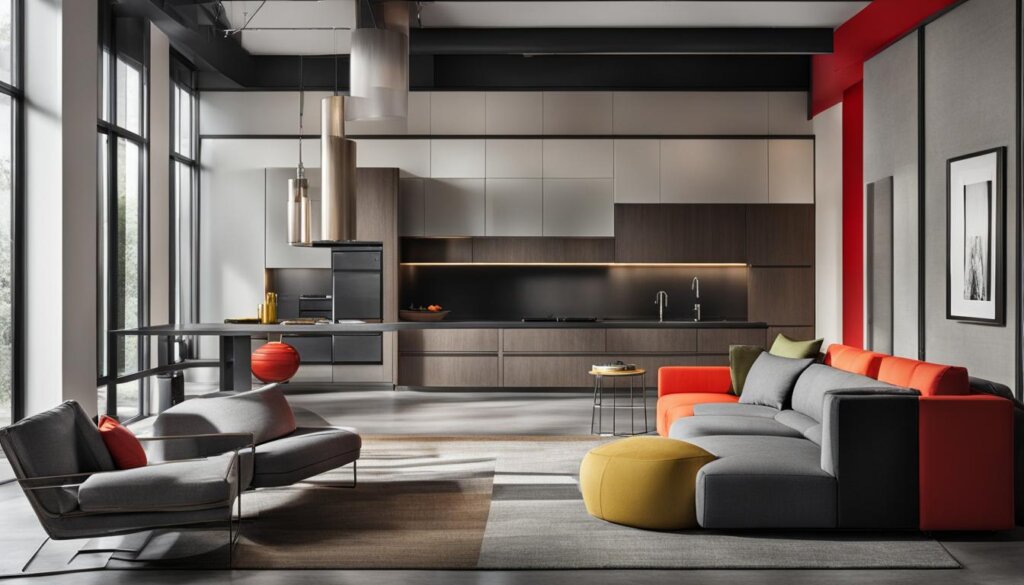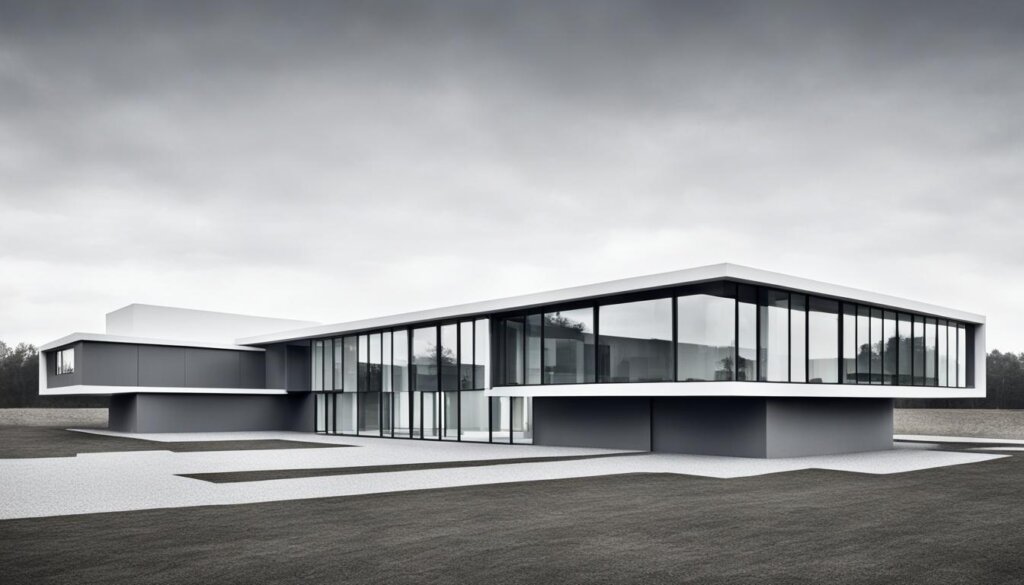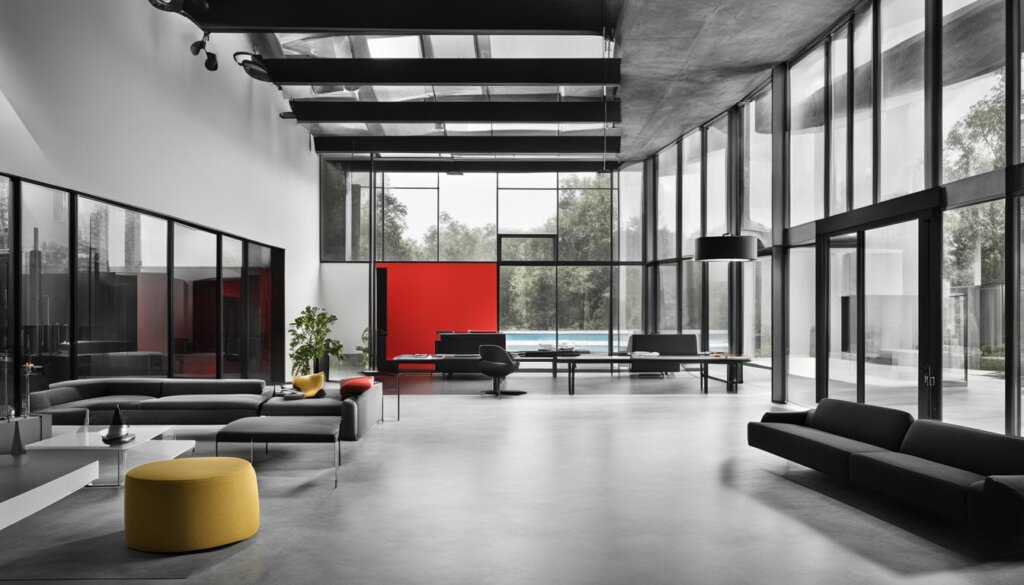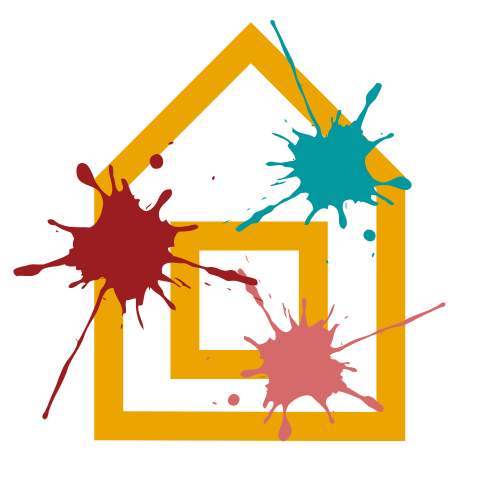Welcome to our article on the fascinating world of Bauhaus art. In this series, we will dive into the history, principles, and lasting legacy of the Bauhaus movement. Join us as we explore the captivating world of Bauhaus design, where art and functionality seamlessly blend together.
The Bauhaus movement, which emerged in the early 20th century, revolutionized the art and design landscape. Bauhaus artists and designers sought to break free from conventional norms and create a visual language that combined form and function. Their innovative approach to art and design laid the foundation for modernist movements, influencing countless artists and designers in the years that followed.
Throughout this series, we’ll delve into the influence of the Bauhaus movement on modern art, architecture, and contemporary design trends. We’ll explore the minimalistic aesthetic, the emphasis on functionality, and the lasting impact of Bauhaus design principles.
Join us as we unravel the timeless appeal of Bauhaus art and the enduring legacy it has left on the world of design.
The Influence of the Bauhaus Movement on Modern Art and Design
The Bauhaus Movement has had a profound influence on modern art and design, shaping the way we perceive and interact with visual culture. Its philosophy of merging art and craft, along with its emphasis on functional aesthetics and minimalist design principles, has left an indelible mark on contemporary creative practices.
Influenced by the industrial revolution and the desire for functional and accessible design, the Bauhaus Movement sought to break down the boundaries between fine art and craft. By infusing industrial production with an artistic sensibility, the movement revolutionized the way we think about modern art and design.
Bauhaus design is characterized by streamlined geometric forms, the avoidance of excessive decoration, and a focus on clarity and functionality. The movement embraced simplicity and practicality, prioritizing the essential functions of an object over unnecessary embellishments.

Bauhaus designers believed in creating objects that were both aesthetically pleasing and functional. This approach to design challenged traditional notions of decoration and encouraged the use of clean lines and geometric shapes. The movement’s dedication to minimalism and functional aesthetics has permeated contemporary visual culture and continues to shape the design landscape.
The Legacy of Functional Aesthetics
- Streamlined geometric forms
- Focus on functionality
- Emphasis on simplicity and minimalism
- Use of clean lines and geometric shapes
The principles of the Bauhaus Movement have become staples of contemporary design. Whether it’s the sleek lines of a minimalist chair or the simple elegance of a functional lighting fixture, Bauhaus design continues to inspire and influence modern art and design.
The Impact of the Bauhaus Movement on Architecture
The Bauhaus Movement, spearheaded by its founder Walter Gropius, had a profound impact on architecture, revolutionizing the way buildings were designed and constructed. Bauhaus architecture, characterized by its innovative use of materials and emphasis on functionality, laid the foundation for the International Style, a prominent architectural movement of the 20th century.
Bauhaus architects embraced new building materials, such as steel and reinforced concrete, which allowed for bold and imaginative designs previously unimaginable. The use of these materials, combined with a focus on minimalism and functionality, gave rise to buildings that were both aesthetically pleasing and structurally sound.
The International Style, influenced by the Bauhaus principles of functionalism and minimalism, further refined the concepts introduced by the movement. This architectural style favored open floor plans, large windows, and a lack of ornamentation, reflecting the Bauhaus philosophy of simplicity and harmony between form and function.

The impact of Bauhaus architecture on the design world cannot be overstated. Its influence can be seen in structures around the globe, from residential homes to iconic landmarks. The blending of art and craftsmanship, the strive for simplicity, and the pursuit of functional aesthetics have become integral to modern architectural practice, continuing to shape the buildings we inhabit today.
The Timelessness of Bauhaus Design
Bauhaus design has stood the test of time and remains relevant today due to its classic yet versatile style. It can adapt to various contexts while maintaining its distinctive look. Bauhaus design can be seen in furniture, lighting, architecture, and interior design, where it blends contemporary ideas with timeless motifs. Its streamlined aesthetic is popular with architects and designers because it can be adapted to fit different traditional and modern spaces.
Adaptability for Any Space
The timeless design of Bauhaus allows it to seamlessly integrate into any space, whether it’s a modern minimalist apartment or a traditional home. Its clean lines and simplistic forms create an atmosphere of elegance and sophistication, while its versatility enables it to harmonize with various design styles.
Whether it’s a Bauhaus-inspired chair in a contemporary living room or a minimalist pendant light in a traditional dining area, these design elements add a touch of modernity and visual interest to any setting.
Incorporating Contemporary Ideas
Although Bauhaus design originated in the early 20th century, it continues to inspire and influence contemporary design trends. Designers today are constantly incorporating Bauhaus principles to create innovative, functional, and aesthetically pleasing pieces.
Bauhaus designers pushed boundaries by experimenting with materials, technology, and forms. This spirit of exploration and innovation resonates with contemporary designers who strive to create products that reflect the needs and aspirations of the modern world.
Timeless Motifs with a Modern Twist
One of the defining features of Bauhaus design is its ability to blend timeless motifs with contemporary ideas. Bold, geometric shapes and primary colors are characteristic of Bauhaus design and have become iconic symbols of modern design.
Today, we see these elements reimagined and incorporated into various design disciplines. From fashion to graphic design, Bauhaus-inspired patterns and color schemes continue to captivate and inspire, proving that the influence of this movement is far-reaching and enduring.
Timeless design, versatility, and contemporary ideas are at the core of Bauhaus design philosophy. Its ability to adapt and evolve over time has solidified its status as a design movement that continues to inspire and shape the world of art, architecture, and design today.
Bauhaus’ Influence on Contemporary Design Trends
The Bauhaus Movement continues to exert a significant influence on contemporary design trends. Its minimalist aesthetic and emphasis on functionality have inspired designers to create pieces that are both visually appealing and practical. By embracing the principles of contemporary design, the Bauhaus Movement has shaped the way we perceive and interact with the objects and spaces around us.
Contemporary design, heavily influenced by the Bauhaus Movement, focuses on clean lines, simplicity, and the elimination of unnecessary embellishments. This minimalist aesthetic creates a sense of harmony and balance, promoting a calm and uncluttered environment.
The functionality aspect of Bauhaus design emphasizes the importance of purpose and usability. Contemporary designers draw on this concept, prioritizing the practicality of their creations while maintaining a visually pleasing appearance. This approach ensures that the objects fulfill their intended function while seamlessly integrating into our daily lives.
Influence on Design Movements
Beyond its direct influence, the Bauhaus Movement has also inspired other significant design movements of the 20th century, such as the Memphis Group and Postmodernism.
The Memphis Group, founded in the 1980s, incorporated the Bauhaus principles of geometric shapes, vibrant colors, and unconventional materials into their designs. They embraced a playful and eclectic aesthetic, challenging traditional design norms and pushing the boundaries of creativity.
The Postmodernism movement, which emerged in the late 20th century, incorporated the Bauhaus emphasis on functionality while embracing a more diverse range of aesthetics. Postmodernism celebrated individualism and eclecticism, highlighting the fusion of different design styles and influences.

This image perfectly captures the essence of contemporary design influenced by the Bauhaus Movement. The clean lines, minimalist aesthetic, and incorporation of functional elements showcase the enduring impact of this design philosophy on contemporary spaces.
Overall, the Bauhaus Movement’s legacy in contemporary design is undeniable. Its emphasis on minimalist aesthetic and functionality continues to shape our understanding of design, creating timeless and adaptable spaces and objects that enhance our everyday lives.
Exploring the Principles of Bauhaus Architecture
The principles of Bauhaus architecture were rooted in functionalism, where form follows function. Bauhaus architects aimed to create buildings that were not only visually appealing but also practical and efficient. This approach emphasized the importance of simplicity, efficiency, and the use of industrial materials.
One of the key figures in Bauhaus architecture was architect Walter Gropius, who played a pivotal role in establishing these principles. Gropius believed that architectural design should prioritize functionality and purpose, rather than ornamental features. His vision paved the way for the development of modernist architecture.
Bauhaus architecture embraced the use of industrial materials such as steel, glass, and concrete, which allowed for innovative designs and construction techniques. By utilizing these materials, architects were able to create structures that were both visually striking and structurally sound.

The Bauhaus movement revolutionized architectural design by promoting the unity of art and craft. It sought to bridge the gap between fine art and practical design, emphasizing the importance of collaboration and interdisciplinary approaches. This approach resulted in buildings that seamlessly integrated art, architecture, and functionality.
Bauhaus architecture also had a lasting impact on the development of the International Style, which emerged in the mid-20th century. This architectural movement, heavily influenced by Bauhaus principles, emphasized open floor plans, large windows, and a lack of ornamentation. The International Style became synonymous with modernist architecture and still influences contemporary design trends today.
The Essence of Bauhaus Design: Form Follows Function
The essence of Bauhaus design lies in the principle of form follows function. This fundamental concept emphasizes that the design of an object should be influenced by its intended purpose and functionality. At Bauhaus, we believe that practicality should always be at the forefront of design, while still maintaining a sense of aesthetic appeal.

When designing objects, Bauhaus designers focused on stripping away unnecessary decorations and ornaments, instead prioritizing the essential functions of the object. By adhering to this principle, Bauhaus designers created functional and utilitarian products that were beautifully crafted.
By rejecting superfluous embellishments and embracing simplicity, Bauhaus design embraced a clean and streamlined aesthetic. This approach sought to eliminate any distractions from the object’s intended purpose, creating a harmonious balance between form and function.
The practicality of Bauhaus design extended beyond just the appearance of objects. It also influenced the use of industrial materials and manufacturing techniques, allowing for efficient and cost-effective production. This practicality not only made Bauhaus design accessible to a wider audience but also contributed to the movement’s lasting impact.
The Impact of Form Follows Function
- Improved functionality: By prioritizing function, Bauhaus design sought to enhance the usability and practicality of everyday objects.
- Simplified aesthetics: Bauhaus design embraced minimalist aesthetics, favoring clean lines, geometric forms, and a lack of unnecessary ornamentation.
- Versatile adaptability: The emphasis on practicality and functionality enabled Bauhaus design to seamlessly integrate into various contexts and spaces.
- Influence on modern design: The principle of form follows function remains a cornerstone of modern design principles, with its impact reaching far beyond the Bauhaus movement.
At Bauhaus, we continue to uphold the principle of form follows function, combining practicality and aesthetic appeal in our design philosophy. By offering functional and visually pleasing products, we aim to enhance both the everyday lives and the overall aesthetic experiences of our customers.
Essential Elements of Bauhaus Design
When it comes to Bauhaus design, several essential elements embody its distinctive aesthetic. Minimalism and simplicity are at the core of this design philosophy, emphasizing the beauty of clean lines and uncluttered spaces. Bauhaus designers sought to strip away unnecessary embellishments and focus on the essential form and function of objects.
Industrial materials are another hallmark of Bauhaus design. Instead of traditional materials, such as wood or stone, designers embraced the use of materials like steel, glass, and concrete. This integration of industrial materials added a modern and utilitarian touch to Bauhaus creations.
Bauhaus design is also characterized by its experimentation with technology. The movement embraced the advancements of the time, incorporating new manufacturing processes and machine-made techniques into their designs. This innovative approach became a catalyst for future design innovations.
The unity of art and craft is a fundamental principle of Bauhaus design. It emphasized the importance of bringing together fine art and practical craftsmanship, blurring the lines between the two disciplines. This union resulted in objects that were not only functional but also visually appealing.
In Bauhaus design, primary colors and geometric shapes reign supreme. Bold and vibrant primary colors, such as red, blue, and yellow, were used to create dynamic visual contrasts. Geometric shapes, including squares, triangles, and circles, were favored for their simplicity and ability to create a sense of harmony and balance.
Typography and graphic design play an integral role in Bauhaus design. The movement emphasized the importance of clear and legible typography and embraced the use of sans-serif fonts, which became a signature element of Bauhaus graphic design. This focus on typography added another layer of functionality to Bauhaus creations.
Overall, these essential elements collectively contribute to the clean, functional aesthetic that defines Bauhaus design. By embracing minimalism, industrial materials, technology, and the unity of art and craft, the Bauhaus movement revolutionized design and continues to inspire modern design principles today.

